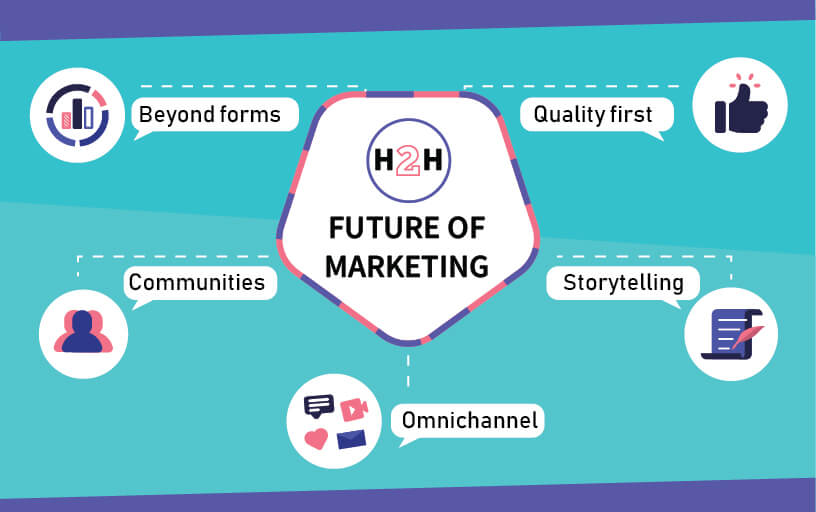we’ve been trained to speak “business to business” (B2B) or “business to consumer” (B2C). But Bryan Kramer instead of this creating a simple framework for dialogue between humans, set forth an unnatural language for marketers, using words like “synergy” and “speeds and feeds” to tell the stories of products and services to their buyers and partners. The fact is that businesses do not have emotion. Products do not have emotion. Humans do. Humans want to feel something. And humans make mistakes. In Human to Human #H2H, He explores the many facets of why and how communication today needs to be adjusted to keep up with our ever-evolving and fast-moving social and digital world. Through anecdotes from his own experiences as president of a Silicon Valley marketing firm, he both inspires new ways of finding commonality in our humanity, but also practical tools to think like a human marketer again.
Specifically, you’ll learn: – The Four Rules of Social Context – How Human Sensory Building will make you a better Marketer – The Secrets to Making Ideas Crowd Worthy, with real-world examples – How to be “Delightfully Disruptive” – Insights into building a Social Business – What it means to have a “Focker Moment” and why they should be celebrated Embedded are short intimate video conversations with some of today’s most forward-thinking humans;
The Simple Yet Genuine Human to Human (H2H) Experience
Communication shouldn’t be complicated. It should just be as genuine and simple as talking to your friend or loved one about something you share a mutual interest in. This is the basis of how human-to-human (H2H) marketing can help companies to create a compelling narrative that will help them make connections with people who can appreciate their stories.
The key to H2H lies in the ability to craft a storyline around your campaign that makes people care about what you’re selling. This will ensure your message will have a much stronger impact on with those who your message has resonated with. H2H looks to create a sturdy bond between brand and customer through the creation of content that adds a human element to the brand. This helps the customer identify with the brand and come to realize that the company is made of real people who care about certain causes other than continuously pushing you to buy their products via traditional advertisements.
How Does H2H Differ From B2C and B2B?
Not every company fits into the mold of Business-to-Business (B2B) or Business-to-Customer (B2C) business models. Whereas B2B focuses on giving a full picture of the company’s products to various business stakeholders via identifying technical aspects that may be of benefit to their organization, B2C focuses on a different approach. With B2C, the focus is on selling products to consumers in a way that tells the story of how enjoyable the product will be for them once they purchase it.
Although most companies may fall into these business models, others aren’t focused on competing with big-box retailers (B2C) or robust corporate services businesses (B2B) who are driven by massive quantities of sales to consumers and/or through their wholesale channels. Instead, these companies are focused on building their repertoire and engaging with customers directly on cause-focused campaigns via Human-to-Human (H2H) marketing. The difference is that these H2H campaigns are not focused on selling products or services like B2C or B2B. For H2H, it’s all about creating a community of trust and mutual understanding through the content.
As more companies begin to roll out omnichannel experiences that give consumers added convenience, there is an inherent expectation that consumers have on brands to be able to link their shopping experiences with their experiential needs. By bringing in elements of what consumers see and are inspired by in their everyday life, it adds a measure of relatability that helps them gravitate towards the brand over time.
Which Industries and Companies Are Best Suited For H2H?
What companies and industries are beginning to realize is that humans tell the best stories which is the key to good marketing. No company understands this sentiment better than Starbucks. The global coffee behemoth recently launched its first global brand campaign where they put their customers at the center of the story. Instead of focusing on the coffee or the company, Starbucks chose to chronicle a day in the life of a cup of their signature coffee through a mini-documentary aimed to show beautiful moments of connection between their customers around the world. The multi-dimensional aspect of this type of campaign shows that anyone can enjoy Starbucks products.
The Key To Success When It Comes To H2H Marketing
Unlike B2B or B2C where sales conversions are the primary measurement of success, H2H is focused on campaign engagement to ensure that the right people are matching your ideal customer profile. Maintaining a high level of customer empathy is a big part of H2H that can help companies produce more relevant products for their target demographics. As you begin to incorporate H2H philosophies into your market campaigns, you should focus on incorporating outreach efforts that encourage them to learn about something other than just their products.
The more you demonstrate that you are listening to your audience and understanding their needs, the more connected they will be with your organization. You can win them by adding humor to your marketing and creating a unique personality that humans can relate to. Lastly, the key to maintaining a solid H2H business model is to own up to your mistakes. If you make a mistake, then own up to it. People will appreciate the authentic apology and you can use that to create a connection via a human response to the matter which will only help your outreach efforts in the future.
The Key To Success When It Comes To H2H Marketing
Unlike B2B or B2C models, H2H is focused on campaign engagement to ensure that the right people are matching your ideal customer profile. Maintaining a high level of customer empathy is a big part of H2H that can help companies produce more relevant products for their target demographics. As you begin to incorporate H2H philosophies into your market campaigns, you should focus on incorporating outreach efforts that encourage them to learn about something other than just their products.
The more you demonstrate that you are listening to your audience and understanding their needs, the more connected they will be with your organization. You can win them by adding humor to your marketing and creating a unique personality that humans can relate to. Lastly, the key to maintaining a solid H2H business model is to own up to your mistakes. If you make a mistake, then own up to it. People will appreciate the authentic apology and you can use that to create a connection via a human response to the matter which will only help your outreach efforts in the future.

